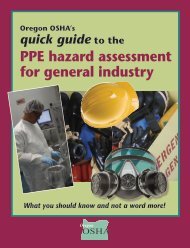Technical Manual - Section 3 (Safety Hazards)
Technical Manual - Section 3 (Safety Hazards)
Technical Manual - Section 3 (Safety Hazards)
You also want an ePaper? Increase the reach of your titles
YUMPU automatically turns print PDFs into web optimized ePapers that Google loves.
@<br />
Other design code vessels<br />
-- Maximum design and allowable pressures<br />
-- Maximum and minimum operating<br />
temperatures<br />
@<br />
Vessel history<br />
-- Alterations, reratings, and repairs performed<br />
-- Date(s) of changes or repairs<br />
@<br />
@<br />
Vessel materials<br />
-- ASME, ASTM, or other specification names<br />
and numbers for the major parts<br />
Design corrosion allowance<br />
IN-SERVICE INSPECTION<br />
Information about inspections performed on the vessel or tank<br />
and the results obtained that will assist in the safety<br />
assessment include the following items:<br />
@<br />
@<br />
Thermal stress relief (PWHT, postweld heat<br />
treatment)<br />
-- Design code requirements<br />
-- Type, extent, and conditions of PWHT<br />
performed<br />
Nondestructive examination (NDE) of welds<br />
-- Type and extent of examination performed<br />
-- Time when NDE was performed (before or<br />
after PWHT or hydrotest)<br />
SERVICE HISTORY<br />
Information on the conditions of operating history of the<br />
vessel or tank that will be helpful in safety assessment include<br />
the following items:<br />
@<br />
Fluids handled<br />
-- Type and composition, temperature and<br />
pressures<br />
@<br />
@<br />
@<br />
@<br />
Inspection(s) performed<br />
-- Type, extent, and dates<br />
Examination methods<br />
-- Preparation of surfaces and welds<br />
-- Techniques used (visual, magnetic particle,<br />
penetrant test, radiography, ultrasonic)<br />
Qualifications of personnel<br />
-- ASNT (American Society for Nondestructive<br />
Testing) levels or equivalent of examining<br />
and supervisory personnel<br />
Inspection results and report<br />
-- Report form used (NBIC NB-7, API 510 or<br />
other)<br />
-- Summary of type and extent of damage or<br />
cracking<br />
-- Disposition (no action, delayed action or<br />
repaired)<br />
@<br />
@<br />
Type of service<br />
-- Continuous, intermittent or irregular<br />
Significant changes in service conditions<br />
-- Changes in pressures, temperatures, and fluid<br />
compositions and the dates of the changes<br />
SPECIFIC APPLICATIONS<br />
Survey results indicate that a relatively high proportion of<br />
vessels in operations in several specific applications have<br />
experienced inservice related damage and cracking.<br />
Information on the following items can assist in assessing the<br />
safety of vessels in these applications:<br />
III:3-11
















